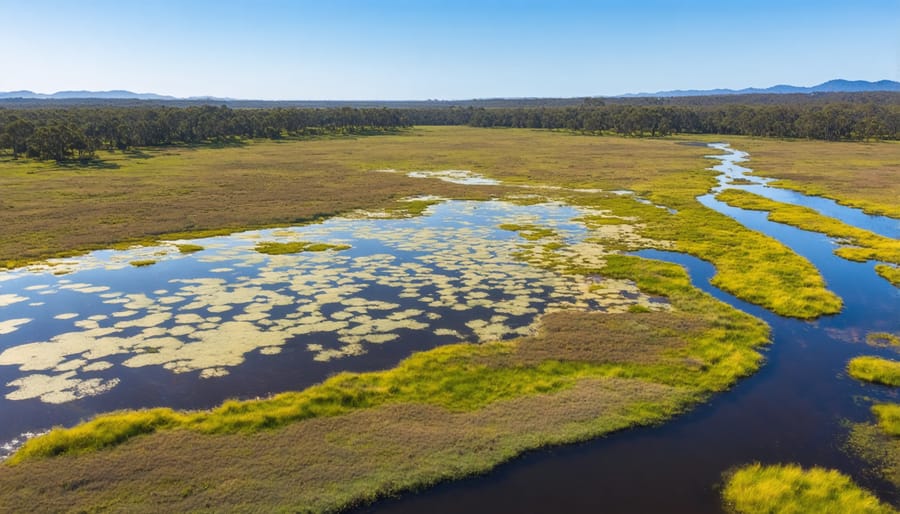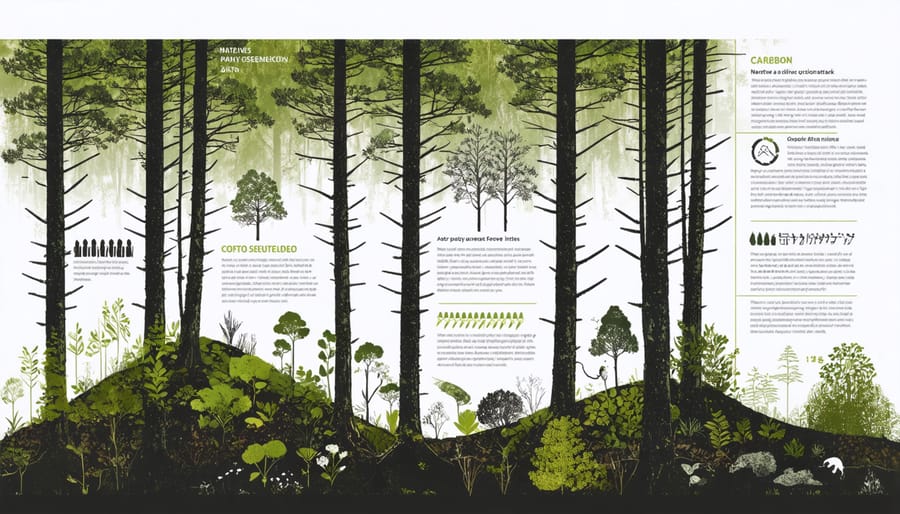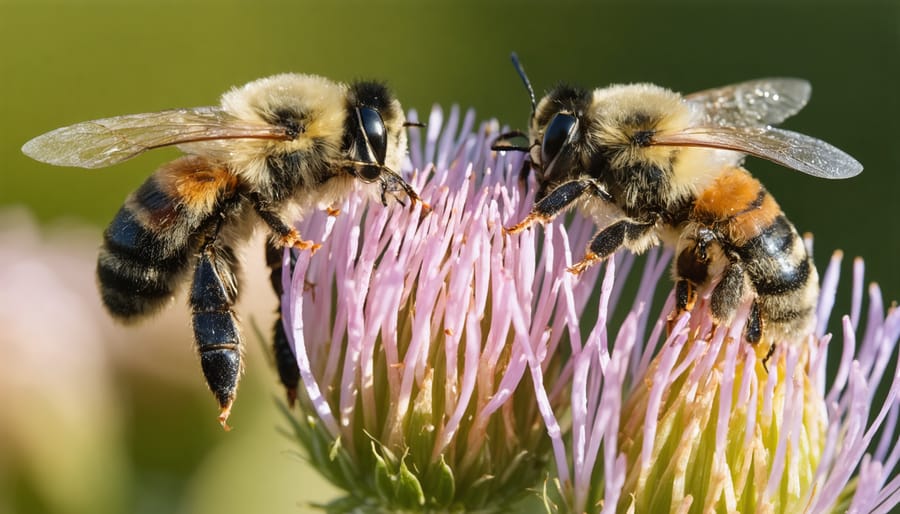Nature’s silent workforce underpins every aspect of our modern Australian economy, delivering services worth billions of dollars annually – all without sending an invoice. When choosing sustainable service providers, understanding these vital ecosystem services helps businesses make smarter decisions that benefit both their bottom line and our environment.
From the coastal mangroves protecting our shorelines to the busy bees pollinating our crops, Australia’s natural systems provide five essential services that power our economy and sustain our communities. These services – water filtration, carbon sequestration, pollination, natural pest control, and soil fertility – work tirelessly around the clock, creating a foundation for sustainable business operations across every sector.
As climate change intensifies and biodiversity faces unprecedented challenges, recognising and protecting these ecosystem services isn’t just environmentally responsible – it’s smart business. By understanding how these natural processes support our operations, Australian businesses can better align their practices with nature’s rhythms, ensuring long-term sustainability while maintaining competitive advantage.
Let’s explore these five crucial ecosystem services and discover how they can transform your approach to sustainable business operations.
Natural Water Purification Systems
Australian Wetlands at Work
Australia’s wetlands are nature’s master purifiers, working tirelessly to clean our water systems across the continent. The Winton Wetlands in Victoria showcase this remarkable process, where native plants like bulrushes and reeds filter out pollutants and excess nutrients from water as it flows through their root systems. These natural filtration systems save local councils millions in water treatment costs while providing essential habitat for wildlife.
In the Northern Territory, the Mary River wetlands demonstrate how these ecosystems can reduce sediment loads and filter agricultural runoff before it reaches sensitive areas like the Great Barrier Reef. The system naturally processes thousands of litres of water daily, improving water quality for both wildlife and nearby communities.
Urban wetlands, such as Sydney’s Olympic Park wetlands, prove that these natural purification systems can thrive even in city environments. These constructed wetlands help manage stormwater runoff, reduce urban pollution, and create green spaces for community enjoyment. They’re living proof that working with nature, rather than against it, can provide cost-effective solutions for water management while supporting local biodiversity.

Cost Benefits for Businesses
Australian businesses are discovering significant cost advantages by leveraging natural water purification systems, making them an increasingly attractive option for sustainable business investments. Local companies implementing these ecosystem services report up to 60% reduction in water treatment costs compared to traditional mechanical systems.
For instance, wetlands and biofilters naturally remove pollutants and sediments, reducing the need for expensive chemical treatments and infrastructure maintenance. A Sydney-based beverage manufacturer saved $180,000 annually by incorporating natural filtration systems into their operations, while also enhancing their environmental credentials.
These natural systems require minimal energy input and have lower operational costs than conventional treatment facilities. The initial investment typically pays for itself within 3-5 years through reduced utility bills and maintenance expenses. Additionally, businesses can benefit from government incentives and increased consumer support for environmentally responsible practices.
Many Australian enterprises are also finding that natural water purification systems create valuable wildlife habitats, contributing to biodiversity while solving water management challenges cost-effectively.

Carbon Sequestration and Climate Regulation
Native Forests as Carbon Sinks
Australia’s native forests are remarkable carbon-storing powerhouses, playing a vital role in our fight against climate change. Our ancient eucalyptus forests, particularly those in Victoria and Tasmania, rank among the world’s most efficient natural carbon sinks, storing up to 2,844 tonnes of carbon per hectare.
These forests work tirelessly, drawing carbon dioxide from the atmosphere through photosynthesis and locking it away in their trunks, branches, leaves, and root systems. The rich soil beneath these forests acts as an additional carbon bank, hosting complex networks of fungi and microorganisms that help sequester carbon deep underground.
What makes our native forests particularly special is their resilience and longevity. Unlike plantation forests, these ecosystems have evolved over thousands of years to withstand Australian conditions, creating stable, long-term carbon storage solutions. They also support countless native species while helping to regulate local climate patterns.
Local businesses are increasingly recognising the value of protecting and restoring these natural carbon sinks, with many participating in forest conservation initiatives and carbon offset programs that support native forest regeneration.
Climate Benefits for Local Business
Local businesses across Australia are discovering that healthy ecosystems provide natural climate regulation that directly benefits their bottom line. Through environmentally responsible business practices, companies can leverage these natural cooling and temperature regulation services to reduce energy costs and enhance operational efficiency.
Trees and vegetation around business premises naturally cool the surrounding area through shade and evapotranspiration, potentially reducing air conditioning costs by up to 30%. Many Australian cafes and restaurants have embraced this by creating green outdoor dining spaces, which not only lower cooling costs but also attract more customers seeking comfortable alfresco experiences.
Coastal businesses benefit from mangroves and wetlands that buffer against extreme weather events and regulate local temperatures. Urban farms and rooftop gardens are increasingly popular among city-based businesses, helping regulate building temperature while creating additional revenue streams through fresh produce.
These ecosystem services also contribute to employee wellbeing and productivity. Studies show that workers in naturally climate-regulated environments report higher job satisfaction and fewer heat-stress-related absences during summer months.
Natural Pest Control Services
Indigenous Species Solutions
Australia’s native wildlife plays a crucial role in natural pest management, offering sustainable solutions that reduce the need for chemical interventions. Our iconic microbats, for instance, can consume thousands of insects nightly, including mosquitoes and agricultural pests. A single colony of these nocturnal hunters can protect vast areas of farmland, naturally controlling pest populations.
Native birds like kookaburras and magpies are exceptional pest controllers, feeding on garden-damaging insects, snails, and even small rodents. Their presence in urban and rural landscapes helps maintain a healthy ecological balance. Similarly, blue-tongued lizards are natural allies in garden protection, consuming snails and slugs that would otherwise damage vegetables and ornamental plants.
Even smaller natives like native wasps and ladybirds contribute significantly by targeting specific pest species that threaten crops and gardens. By creating wildlife-friendly spaces and protecting these indigenous species, businesses and homeowners can harness nature’s own pest management system, reducing costs and environmental impact while supporting local biodiversity.
Reducing Chemical Dependence
Australia’s diverse ecosystems offer remarkable natural pest control solutions, helping farmers and land managers significantly reduce their reliance on chemical pesticides. Native birds like the Willie Wagtail and Magpie-lark naturally control insect populations, while beneficial insects such as ladybirds and parasitic wasps keep crop-destroying pests in check.
In the Riverina region, cotton farmers who’ve integrated natural pest management have reported up to 40% reduction in pesticide use, resulting in substantial cost savings and healthier soil. These natural alternatives not only protect crops but also preserve essential pollinators like native bees and butterflies that might otherwise be harmed by chemical sprays.
Local councils across Australia are increasingly turning to biological control methods, such as introducing native predatory insects to manage invasive species in public parks and gardens. This approach has proven particularly effective in controlling common pests like aphids and scale insects while maintaining ecological balance.
By working with nature rather than against it, businesses and farmers can achieve both environmental and economic benefits, creating more resilient and sustainable agricultural systems for future generations.
Soil Formation and Erosion Control
Native Vegetation Benefits
Australia’s native vegetation plays a crucial role in maintaining and enhancing soil quality across our diverse landscape. From the hardy saltbush in our arid regions to the dense undergrowth of our coastal forests, these plants have evolved perfectly suited root systems that bind soil particles together, preventing erosion during heavy rains and strong winds.
Indigenous plants create a natural cycle of soil enrichment. As leaves and branches fall, they break down into nutrient-rich organic matter, feeding beneficial soil microorganisms and creating a self-sustaining ecosystem. This natural mulch also helps retain moisture, reducing water requirements and protecting soil from temperature extremes common in our climate.
The deep root networks of native trees and shrubs are particularly effective at improving soil structure. They create channels for water infiltration, increase soil porosity, and help break up compacted ground. This improved soil structure supports better water retention and allows for healthy root growth of surrounding vegetation.
Many Australian native plants also form beneficial partnerships with soil fungi, enhancing nutrient uptake and soil stability while supporting local biodiversity. This natural relationship helps create resilient soils that better withstand environmental stresses.
Sustainable Land Management
In Australia’s diverse landscapes, sustainable land management practices work hand in hand with natural ecosystem services to create resilient business operations. From the cattle stations of Queensland to the vineyards of South Australia, forward-thinking businesses are discovering the power of working with nature rather than against it.
For example, many Australian farmers now use native vegetation corridors to protect their crops from wind damage while providing habitat for beneficial insects that naturally control pests. These green buffers also help prevent soil erosion, reducing maintenance costs and protecting valuable topsoil.
In urban areas, commercial properties are incorporating green infrastructure like rooftop gardens and permeable surfaces. These features naturally manage stormwater, reduce cooling costs, and create attractive spaces for employees and customers. The Melbourne CBD’s growing network of green roofs demonstrates how businesses can benefit from natural cooling while supporting local biodiversity.
Local councils and businesses are also partnering to restore wetlands that act as natural water filtration systems, reducing water treatment costs while creating recreational spaces for communities. These initiatives show how ecosystem services can deliver both environmental and economic benefits when properly managed.
Pollination Services
Australian Pollinators
Australia’s unique pollinators play a vital role in sustaining our ecosystems and agricultural productivity. While European honey bees often get the spotlight, our native pollinators include countless species of native bees, butterflies, moths, birds, and even small marsupials. The blue-banded bee, with its distinctive metallic stripes, is particularly effective at pollinating tomatoes and eggplants through buzz pollination. Meanwhile, our flying foxes are crucial night-time pollinators for eucalyptus trees and other native flora.
These incredible creatures contribute significantly to our food security, with roughly one-third of Australia’s food production relying on pollination services. Our native pollinators are particularly well-adapted to local conditions and can work in weather conditions that might deter introduced species. For instance, native stingless bees continue foraging during light rain and can access flowers in dense bushland where larger pollinators might struggle.
However, these essential workers face mounting challenges from habitat loss, pesticide use, and climate change. Supporting our native pollinators through urban gardening, reducing chemical use, and maintaining natural vegetation corridors helps ensure the continuation of this vital ecosystem service.

Supporting Natural Pollination
Australian businesses are increasingly recognising the vital role of natural pollinators in maintaining healthy ecosystems and supporting agricultural productivity. Simple yet effective strategies can help enhance pollination services in both urban and rural settings. Creating pollinator-friendly gardens with native flowering plants like bottlebrush, banksia, and grevillea provides year-round food sources for local bees and other pollinators.
Implementing buffer zones between crops and maintaining diverse vegetation corridors helps create safe passage for pollinators across landscapes. Many Australian farmers are now reducing chemical pesticide use and adopting integrated pest management approaches to protect beneficial insects. Some businesses are partnering with local beekeepers to install native beehives on their properties, supporting both honey production and natural pollination.
Urban businesses can contribute by incorporating rooftop gardens and vertical green spaces into their buildings. These green installations not only support pollinators but also provide additional benefits like natural cooling and improved air quality. Community initiatives, such as neighbourhood pollinator gardens and educational workshops, are helping raise awareness about the importance of these essential ecosystem services while fostering local environmental stewardship.
Ecosystem services are not just natural processes; they’re the foundation of our economic and social well-being in Australia. By understanding and protecting these vital services, businesses can make ethical business decisions that benefit both their bottom line and our environment. Start by assessing your company’s impact on local ecosystems and identifying opportunities to work in harmony with nature. Consider implementing green infrastructure, supporting local conservation efforts, and developing partnerships with Indigenous communities who have long understood the value of these services. Remember, every action counts – whether it’s creating a workplace garden to support pollinators or reducing water consumption to protect our precious water systems. By taking these steps today, we’re investing in a resilient future where business and nature thrive together.
